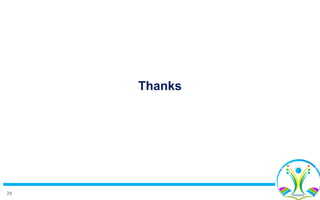Vitamin D level in Sulaimani City and its correlation with Age, Gender and Season.pptx
- 1. This presentation is based on my published article in conference paper that held by Koya University Vitamin D level study within the population of Sulaimani City ŌĆō IRAQ Sakar Ahmed Abdullah PhD molecular biology Sulaimani Polytechnic University sakar.ahmed@spu.edu.iq
- 2. 2 Presentation Outline ’āś Motivations. ’āś Background and introduction ’āś Research methods ’āś Results ’āś Discussion ’āś Conclusions & Recommendation ’āś References
- 3. 3 Motivations ’āś Vitamin D3 regulates the uptake of calcium from the intestinal tract and enhances bone growth. Vitamin D3 deficiency causes many health problems such as autoimmune diseases, Crohn's disease, diabetes, inflammation, asthma, hypertension, and cancer. ’āś Vitamin D3 (Cholecalciferol) deficiency has been documented as a persistent problem among adults, children, and elderly persons in most countries especially during winter. One-third of the worldwide population suffers from Vitamin D3 hypovitaminosis due to inadequate exposure to sunlight. ’āś Our primary objective of this study was to determine the prevalence of vitamin D3 deficiency among the Sulaimani City population, the secondary objective was to determine whether a gender variation affects serum levels of vitamin D3. Last, we sought to identify the prevalence of vitamin D3 deficiency within different ages. ’āś For this aim, 3519 cases from the Central Laboratory of Disease Analysis in Sulaimani were enrolled from 26 November 2014 to 24 May 2017. Serum level of Vitamin D3 (1,25-dihydroxy vitamin D) was determined by Cobas e411 (Hitachi- Germany) technique. To assess a basis for interpretation of potential relationships in our results statistical analyses were conducted with a commercially available software Graph Pad Prism 6.0 (WI, USA).
- 4. 4 Background and introduction ’āś Vitamin D deficiency is common worldwide and more prevalent in the United States[1] and its deficiency is an epidemic among both children and adults, especially in elderly persons [2]. ’āś Vitamin D3 1,25-dihydroxyvitamin D or 1,25-(OH) 2 D is an active Vitamin D hormone [3]. ’āś The major source of Vitamin D3 is produced by the skin due to exposure to ultraviolet radiation of sunlight or after exposure to artificial ultraviolet light. ’āś Solar ultraviolet B (UVB) radiation is absorbed by 7-dehydrocholesterol in the skin, triggering the production of pre-vitamin D3. This is then converted in the liver to 25-hydroxyvitamin D3 (25(OH)D3). In the kidney, the enzyme 1╬▒-hydroxylase catalyzes a final hydroxylation step, producing the biologically active form, 1,25-dihydroxyvitamin D3 as shown in Figure 1 [4,5]. ’āś Vitamin D produced in the skin may last in the blood twice longer than ingesting vitamin D [4,6] ’āś There are many studies have reported associations between cardiovascular disease, coronary heart disease, and hypertension with lower vitamin D levels [1], Moreover, even a slight Hypovitaminosis of vitamin D causes an increase in bone atrophy [8] ’āś Excessive exposure to sunlight can have serious consequences and significantly increases the risk of nonmelanoma skin cancer, thus Typical exposure to sunlight is usually 2 or 3 times per week 5ŌĆō10 min [13,14]. ’āś To determine whether a person is vitamin D (either vitamin D2 or vitamin D3) sufficient, deficient, or intoxicated the circulating concentrations of 25(OH)D were measured. A level less than 20 ng/mL indicates severe vitamin D deficiency, a level of 20-30 indicates insufficient, while a level of 30-50 ng/mL is considered as adequate for healthy people
- 5. 5 Background and introduction Figure 1 Production of the D3 by direct exposure to the sunlight or from dietary sources
- 6. 6 Material and Method ’āś A total of 3520 patients including 574 male and 2945 female patients, aged between 16 to 94 years old clinically diagnosed at the beginning of November 2014 to the end of June 2017 in the central laboratory in (Sulaimani Iraq) were included in this study. ’āś A control group sample collected from 25 individuals who were visiting the ENT hospital in (Sulaimani/Iraq) suffering from respiratory system diseases were enrolled in our study. ’āś 5 ml of venous blood was obtained from the patient and control groups were collected in a clot activator tube for measuring Vitamin D3 1,25-dihydroxy vitamin D (ng/mL) in serum. Serum level of Vitamin D3 (1,25-dihydroxy vitamin D) was determined by Cobas e411 (Hitachi- Germany) technique.
- 7. 7 Results ’āś A total of 3519 subjects were enrolled in this study consisting of 574 men and 2946 women clinically diagnosed in the central laboratory in Sulaimani/Iraq. Gender Frequency Percent Female 2945 83.68 % Male 574 16.32 % Total 3519 100.0 TABLE 1 Percentage of the study population with respect to gender
- 8. 8 Gender N Mean (ng/mL) Std. Deviation Std. Error Mean Female 2945 13.328 11.63816 0.21446 Male 574 16.232 12.86351 0.53691 TABLE 2 Mean (┬▒SD) values of Serum 25(OH) D of both gender group Using the independent t-test, the F value and the significance of the difference between the mean of both male and female participants have been statistically calculated. The mean for the level of Vitamin D in the serum of the entire group has been calculated as 13.80 with SD┬▒11.89. However, the mean of the serum level of vitamin D in the male group was 16.23 with SD┬▒12.86, higher than the female group which was 13.32 with SD┬▒11.63. Results
- 9. 9 ’āś There was a significant difference in male groups (M=16.2323, SD=12.86351) and female group (M=13.3282, SD=11.638) conditions; t (3517) =1.117, p = 0.0001 These results suggest that the significant difference value of the population was smaller than 0.05 (P > 0.05), thus we reject the null hypothesis and statistically confirmed there were differences between the two groups F Sig. T D f Sig.(2-tailed) 1.17 0.291 -5.373 3517 0.000 -5.023 766 0.000 TABLE 3 An independent-samples t-test was conducted to compare the mean of vitamin D level in blood between male and female groups Results
- 10. 10 ’āś Association between vitamin D3 deficiency and patients age was assessed in our study Results Vitamin D3 levels Age 16-30 30-45 45-60 60-80 80-94 Mean & STD 8.53 ┬▒ 11.4 9.6 ┬▒ 11.5 10.5 ┬▒ 12.1 11.6 ┬▒ 11.8 14.84 ┬▒ 15.9 Deficiency 443 (85.7%) 983 (85.5%) 859 (80.3%) 560 (75.3%) 26 (60.5%) Insufficient 44 (8.6%) 98 (8.5%) 124 (11.6%) 112 (15.1%) 4 (9.3%) Sufficient 29 (5.7%) 69 (6%) 87 (8.1%) 71 (9.6%) 13 (30.2%) TABLE 4 Association between age and vitamin D3
- 11. 11 Results ’āś The population based on the level of vitamin D in their serum in respective with Roche company reference range for vitamin D level Figure 2. Vitamin D3 levels in Sulaimani population
- 12. 12 ’āś The sample tests have been grouped based on the collection time of the year Season Sept. to December December to March March to Jun Jun to Sept. N. 534 958 1330 697 Mean ┬▒SD 12.73 ┬▒ 11.49 13.54 ┬▒ 11.72 13.53 ┬▒12.21 15.48┬▒11.65 TABLE 5 Mean┬▒SD of sample tests grouped based on season. Results
- 13. 13 ’āś t-test used to determine the difference in the mean of Vitamin D level that has been grouped based on the months in the year TABLE 6 An independent-samples t-test was conducted to compare the mean of vitamin D level of grouped subjects based on seasons. Mean Difference between seasons T Df Sig.(2-tailed) Pair 1 (DecemberToMarch) ŌĆō (MarchToJun) 2.137 957 .033 Pair 2 (DecemberToMarch) ŌĆō (JunToSept) -2.929 696 .004 Pair 3 (DecemberToMarch) ŌĆō (SeptToDec) .348 533 .728 Pair 4 (MarchToJun) ŌĆō (JunToSept) -5.103 696 .000 Pair 5 (MarchToJun) ŌĆō (SeptToDec) -.532 533 .595 Pair 6 (JunToSept) ŌĆō (SeptToDec) 3.339 533 .001 Results
- 14. 14 ’āś Finally, 21 subjects taken from ENT department as a control group, the mean of control group were 28.95 ng/ml, while the mean of studied group 13.8019 ng/ml Table 7. Groups N. Mean Std. Deviation Control Group 21 28.9564 13.17817 Study Group 3519 13.8019 11.89327 TABLE 7 The mean and SD of both control and study group. Results
- 15. 15 Discussions ’āś The main goal of this prospective study was to determine the deficiency level of vitamin D in Sulaimani City ŌĆōIRAQ. Then to determine the effect of age, sex, and season on the level of vitamin D. High level of vitamin D deficiency has been reported in IRAQ. ’āś Sulaimani area has semi-arid climates that are very hot and dry during summer while in winter it's wet and cold. However, this area has four seasons but most of the time there are sunny days. Thus, the expectation for the vitamin D level in the serum of the population should be high. ’āś This study concluded with 3519 subjects with 25 control groups from the ENT department. The test subjects are grouped based on Sex and found to be 574 men and 2946 women clinically diagnosed in the central laboratory in Sulaimani in Iraq, as shown in Table 1. ’āś In our study, we found that the p-value was lower than 0.05 and the null hypothesis was accepted Table 3. This indicates that there was a difference in the level of vitamin D between both male and female groups which may be due to men tending to be working outside more than women in this region which has a direct effect on the amount of sun exposure. ’āś 2869 patients had vitamin D levels in serum (<20) ng/ml with a mean of (8.4 ┬▒ 4.43) ’āś 383 of patients were at vitamin D3 insufficiency level) (20 - 30) ng/ml with a mean of (24 ┬▒ 2.9). ’āś 264 patients were at vitamin D3 sufficient level (30-100) ng/ml with a mean of (40.3 ┬▒ 14.1) ’āś Four patients were at excess level of vitamin D (100-150) ng/ml with a mean of (102.5 ┬▒ 1.8),
- 16. 16 ’āś No patients were at an intoxication level of vitamin D3 >150 ng/ml. ’āś The reason for the high percentage of vitamin D deficiency within this study population may be due to the sun being very hot most of the time in the year which makes the people living in this area try to stay away from direct exposure to the sun, thus causing less acquirement of vitamin D from sun exposure. ’āś Subjects grouped based on age, the mean of the vitamin D level increased with age, as shown in Table2 ’āś The mean vitamin D level for the first group aged between 16-30 was 8.53 ng/ml, The second group aged 30-45 was 9.6 ng/ml. The third group aged 45-60 were 10.5 ng/ml. The fourth group aged 60-80 years old was 11.6 ng/ml. The fifth group was 80 years old and above with a mean vitamin D level of 14.84. ’āś The reason for this difference in mean vitamin D level can be due to elders having more healthy foods and being exposed to sunlight more frequently than younger ones. However, this result disagrees with previous study by [8]. ’āś Finally, we have collected samples from the ENT department to use them as a control group. Then the mean and SD of the control group were calculated and compared with the study group Table 7. The p < 0.005, thus we rejected the null hypothesis and found that there was a difference in the control group to those of the study group. Discussions
- 17. 17 Conclusion ’āś This study found that age, sex, and season affect the level of vitamin D level within the population of Sulaimani City.
- 18. 18 Recommendation ’āś Ōśæ’ĖÅMandatory vitamin D screening in Sulaimani. ’āś Ōśæ’ĖÅPublic health campaigns for sunlight exposure.
- 19. 19 References [1] T. J. Wang et al., ŌĆ£Vitamin D deficiency and risk of cardiovascular disease,ŌĆØ Circulation, vol. 117, no. 4, pp. 503ŌĆō511, 2008. [2] H. Michael, ŌĆ£Vitamin D Deficiency,ŌĆØ pp. 266ŌĆō281, 2007. [3] H. DIXON, ŌĆ£International Union of Pure and Applied Joint Commission on Biochemical Nomenclature *,ŌĆØ Pure Appl. Chem., vol. 56, no. 5, pp. 595ŌĆō624, 1984. [4] M. F. Holick and T. C. Chen, ŌĆ£Vitamin D defciency: a worldwide problem with health consequences,ŌĆØ Am. J. Clin. Nutr., vol. 87, no. 4, p. 1080SŌĆō6S, 2008. [5] S. M. Parigi, M. Eldh, P. Larssen, S. Gabrielsson, and E. J. Villablanca, ŌĆ£Breast milk and solid food shaping intestinal immunity,ŌĆØ Front. Immunol., vol. 6, no. JUL, pp. 1ŌĆō21, 2015. [6] M. F. Holick et al., ŌĆ£Evaluation, treatment, and prevention of vitamin D deficiency: An endocrine society clinical practice guideline,ŌĆØ J. Clin. Endocrinol. Metab., vol. 96, no. 7, pp. 1911ŌĆō1930, 2011. [8] J. C. Gallagher, ŌĆ£Vitamin D and aging.,ŌĆØ Endocrinol. Metab. Clin. North Am., vol. 42, no. 2, pp. 319ŌĆō32, Jun. 2013. [13] M. B. Veierod et al., ŌĆ£A prospective study of pigmentation, sun exposure, and risk of cutaneous malignant melanoma in women,ŌĆØ J Natl.Cancer Inst., vol. 95, no. 20, pp. 1530ŌĆō1538, 2003. [14] C. Kennedy, C. D. Bajdik, R. Willemze, F. R. De Gruijl, and J. N. Bouwes Bavinck, ŌĆ£The influence of painful sunburns and lifetime sun exposure on the risk of actinic keratoses, seborrheic warts, melanocytic nevi, atypical nevi, and skin cancer,ŌĆØ J. Invest. Dermatol., vol. 120, no. 6, pp. 1087ŌĆō1093, 2003. [15] A. M. Issa and S. A. Ibraheem, ŌĆ£Alterations of Vitamin ŌĆś D ŌĆÖ level in Sera of Iraqi Population,ŌĆØ J. Kerbala Univ., vol. 5, no. 1, pp. 58ŌĆō64, 2007.
- 20. 20 Thanks
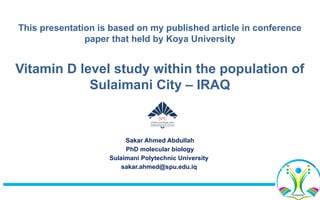

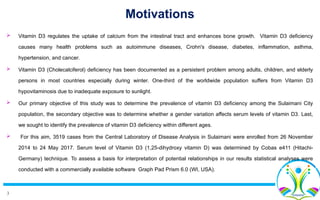
![4
Background and introduction
’āś Vitamin D deficiency is common worldwide and more prevalent in the United States[1] and its deficiency is an epidemic
among both children and adults, especially in elderly persons [2].
’āś Vitamin D3 1,25-dihydroxyvitamin D or 1,25-(OH) 2 D is an active Vitamin D hormone [3].
’āś The major source of Vitamin D3 is produced by the skin due to exposure to ultraviolet radiation of sunlight or after exposure
to artificial ultraviolet light.
’āś Solar ultraviolet B (UVB) radiation is absorbed by 7-dehydrocholesterol in the skin, triggering the production of pre-vitamin
D3. This is then converted in the liver to 25-hydroxyvitamin D3 (25(OH)D3). In the kidney, the enzyme 1╬▒-hydroxylase
catalyzes a final hydroxylation step, producing the biologically active form, 1,25-dihydroxyvitamin D3 as shown in Figure
1 [4,5].
’āś Vitamin D produced in the skin may last in the blood twice longer than ingesting vitamin D [4,6]
’āś There are many studies have reported associations between cardiovascular disease, coronary heart disease, and
hypertension with lower vitamin D levels [1], Moreover, even a slight Hypovitaminosis of vitamin D causes an increase in
bone atrophy [8]
’āś Excessive exposure to sunlight can have serious consequences and significantly increases the risk of nonmelanoma skin
cancer, thus Typical exposure to sunlight is usually 2 or 3 times per week 5ŌĆō10 min [13,14].
’āś To determine whether a person is vitamin D (either vitamin D2 or vitamin D3) sufficient, deficient, or intoxicated the
circulating concentrations of 25(OH)D were measured. A level less than 20 ng/mL indicates severe vitamin D deficiency, a
level of 20-30 indicates insufficient, while a level of 30-50 ng/mL is considered as adequate for healthy people](https://image.slidesharecdn.com/vitamindlevelinsulaimanicityanditscorrelationwithagegenderandseason-250313145325-f7b9bd66/85/Vitamin-D-level-in-Sulaimani-City-and-its-correlation-with-Age-Gender-and-Season-pptx-4-320.jpg)
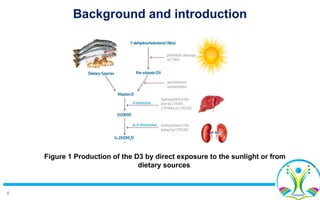
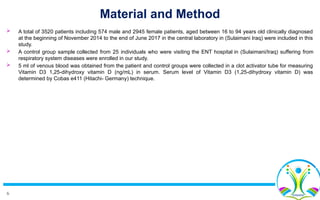
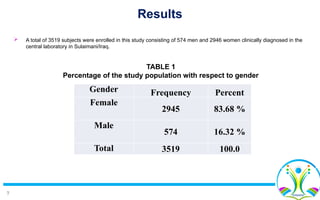
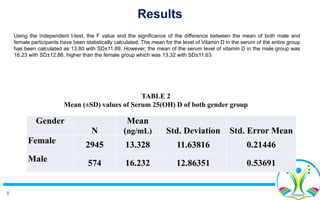
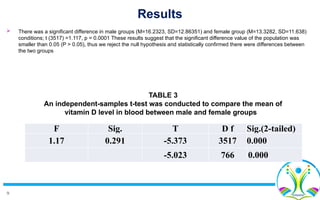
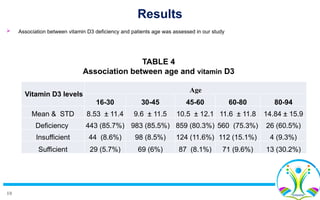
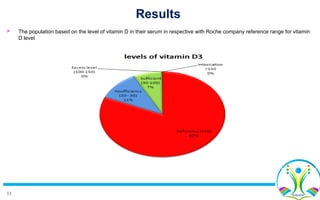
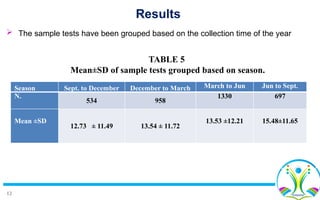
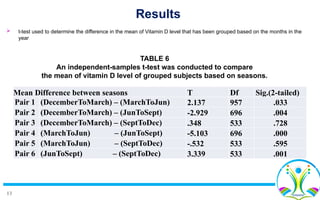
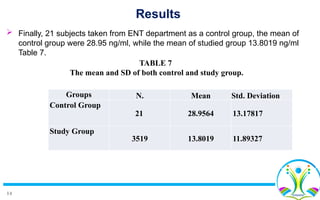
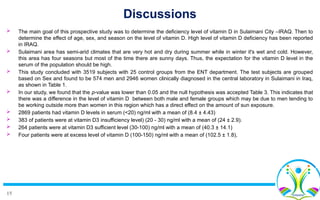
![16
’āś No patients were at an intoxication level of vitamin D3 >150 ng/ml.
’āś The reason for the high percentage of vitamin D deficiency within this study population may be due to the sun being very hot
most of the time in the year which makes the people living in this area try to stay away from direct exposure to the sun, thus
causing less acquirement of vitamin D from sun exposure.
’āś Subjects grouped based on age, the mean of the vitamin D level increased with age, as shown in Table2
’āś The mean vitamin D level for the first group aged between 16-30 was 8.53 ng/ml, The second group aged 30-45 was 9.6
ng/ml. The third group aged 45-60 were 10.5 ng/ml. The fourth group aged 60-80 years old was 11.6 ng/ml. The fifth group
was 80 years old and above with a mean vitamin D level of 14.84.
’āś The reason for this difference in mean vitamin D level can be due to elders having more healthy foods and being exposed to
sunlight more frequently than younger ones. However, this result disagrees with previous study by [8].
’āś Finally, we have collected samples from the ENT department to use them as a control group. Then the mean and SD of the
control group were calculated and compared with the study group Table 7. The p < 0.005, thus we rejected the null
hypothesis and found that there was a difference in the control group to those of the study group.
Discussions](https://image.slidesharecdn.com/vitamindlevelinsulaimanicityanditscorrelationwithagegenderandseason-250313145325-f7b9bd66/85/Vitamin-D-level-in-Sulaimani-City-and-its-correlation-with-Age-Gender-and-Season-pptx-16-320.jpg)
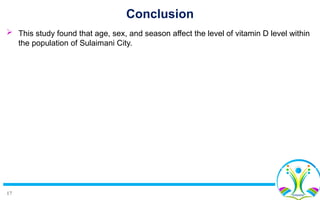
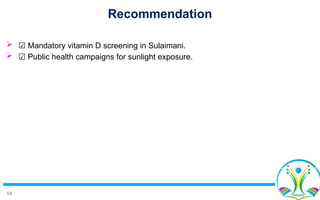
![19
References
[1] T. J. Wang et al., ŌĆ£Vitamin D deficiency and risk of cardiovascular disease,ŌĆØ Circulation, vol. 117, no. 4, pp. 503ŌĆō511, 2008.
[2] H. Michael, ŌĆ£Vitamin D Deficiency,ŌĆØ pp. 266ŌĆō281, 2007.
[3] H. DIXON, ŌĆ£International Union of Pure and Applied Joint Commission on Biochemical Nomenclature *,ŌĆØ Pure Appl.
Chem., vol. 56, no. 5, pp. 595ŌĆō624, 1984.
[4] M. F. Holick and T. C. Chen, ŌĆ£Vitamin D defciency: a worldwide problem with health consequences,ŌĆØ Am. J. Clin.
Nutr., vol. 87, no. 4, p. 1080SŌĆō6S, 2008.
[5] S. M. Parigi, M. Eldh, P. Larssen, S. Gabrielsson, and E. J. Villablanca, ŌĆ£Breast milk and solid food shaping intestinal
immunity,ŌĆØ Front. Immunol., vol. 6, no. JUL, pp. 1ŌĆō21, 2015.
[6] M. F. Holick et al., ŌĆ£Evaluation, treatment, and prevention of vitamin D deficiency: An endocrine society clinical
practice guideline,ŌĆØ J. Clin. Endocrinol. Metab., vol. 96, no. 7, pp. 1911ŌĆō1930, 2011.
[8] J. C. Gallagher, ŌĆ£Vitamin D and aging.,ŌĆØ Endocrinol. Metab. Clin. North Am., vol. 42, no. 2, pp. 319ŌĆō32, Jun. 2013.
[13] M. B. Veierod et al., ŌĆ£A prospective study of pigmentation, sun exposure, and risk of cutaneous malignant melanoma
in women,ŌĆØ J Natl.Cancer Inst., vol. 95, no. 20, pp. 1530ŌĆō1538, 2003.
[14] C. Kennedy, C. D. Bajdik, R. Willemze, F. R. De Gruijl, and J. N. Bouwes Bavinck, ŌĆ£The influence of painful
sunburns and lifetime sun exposure on the risk of actinic keratoses, seborrheic warts, melanocytic nevi, atypical nevi, and skin
cancer,ŌĆØ J. Invest. Dermatol., vol. 120, no. 6, pp. 1087ŌĆō1093, 2003.
[15] A. M. Issa and S. A. Ibraheem, ŌĆ£Alterations of Vitamin ŌĆś D ŌĆÖ level in Sera of Iraqi Population,ŌĆØ J. Kerbala Univ., vol. 5,
no. 1, pp. 58ŌĆō64, 2007.](https://image.slidesharecdn.com/vitamindlevelinsulaimanicityanditscorrelationwithagegenderandseason-250313145325-f7b9bd66/85/Vitamin-D-level-in-Sulaimani-City-and-its-correlation-with-Age-Gender-and-Season-pptx-19-320.jpg)
